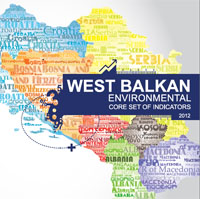| EMMISSION OF THE MAIN POLLUTING SUBSTANCES – EMISSION OF AMMONIA (NH3) | |
The indicator tracks the trends inammonia.
The indicator also provides information on emissions by subsectorsin the key sector – agriculture.
kt (kilotons per year)
What progress has been made in overall reduction of emissions of polluting substance ammonia in the Republic of Macedonia?
In 1990, the total national emissions of NH3 amounted to 15,8 kt. For comparison in 2016, emissions are reduced by 39% and they are about 10,5 kt. The reasons for the declining trend of emissions of this pollutant lie mainly in the reduction of emissions from agriculture (management of fertilizers), which is associated with the cultivation of smaller number of livestock. From 2015 to 2016, emissions are reduced by 9%.
The Diagram below shows the annual trend in ammonia emissions for the period 1990 to 2016.
Diagram 1.Trend in ammonia emissions
Under the CARDS Programme, Inventory of air emissions of the main pollutants in the country was established in 2005 in accordance with the EMEP methodology by individual sectors, i.e. activities, and in 2014 an Inventory including all pollutants was prepared.Starting from 2014, the Republic of Macedonia carries out calculations of national emissions for all pollutants.
The emission sources, within this national indicator, are made according to the following categorization:
| Sector |
| Energy Production and distribution |
| Commercial, instiucional and households |
| Industry (combustion) |
| Industry (production) |
| Fugitive emissions |
| Use of solvents and products |
| Road transport |
| Non-Road transport |
| Waste |
| Agriculture |
| Other |
In the total emissions of ammonia in 2016, the sector Agriculture contributes with share of 89%, followed by the sector Commercial, institutional and households with 7,8% and the sector Fugitive emissions with share of 1,5%.
Diagram 2. Emissions of NH3 bysectors in 2016
Which different NFR categories contribute to ammonia emissions?
Agriculture is the key NFR category for ammonia emissions. Therefore, Diagram 3 shows emissions from the agricultural category by subcategories.
Emissions from livestock breeding originate from urea decomposition in the feces of animals and decomposition of urea in poultry. Ammonia emissions depend on the species of animals, their age, manner of breeding, and waste management and disposal. The main reason for emission reduction is the reduction in the number of bred animals, especially manifested among poultry, sheep, goats and horses owing to declined interest in dealing with livestock breeding activity and increased internal village to town migration of the population.
.
Diagram 3. Emissions of NH3from NFR category agriculture by subcategories per year
 Data coverage: excel
Data coverage: excel
Sources of data: The data used refers to overall national emissions and emissions categorized by NFR delivered by EEA member and collaborating states to EEA and Secretariat of the United Nations. Data is accessible per country on the following web address: http://cdr.eionet.europa.eu/mk/un/clrtap/inventories/envwovm7g/.
- Methodology for indicator calculation
The methodology for this indicator calculation is based on calculated national emissions and emissions by NFR categories of this pollutant as reported to EEA (European Environmental Agency) and UNECE/EMEP (United Nations Economic Commission for Europe/Cooperative programme for monitoring and evaluation for transboundary air pollution transfer under the Convention on Transboundary Air Pollution Transfer) in February 2016. Data used in this report is in accordance with the data submitted, the difference being that additional allocation of national emissions has been made apart from NFR (as sent to international organizations) also by sectors.
Calculations of the emission of this pollutant are in line with the Guidebooks of EMEP/EEA on air emissions inventory taking published in 2009, 2013 and 2016. The Guidebook contains emission factors which have been used in the calculations, except for the energy sector where calculations were made by the use of country specific factors or use of data from the measurements completed in the period 2008-2016 for this polluting substance and for the sector 1A1a concerning electricity and heat producing plants.
Methodology used for calculation and presentation of this indicator is given in EMEP/EEA Guidebook for inventory of air pollutant emissions of 2009, Guidebook of 2013 and Guidebook of 2016 which may be accessed at the following links (http://www.eea.europa.eu/publications/emep-eea-emission-inventory-guidebook-2009, http://www.eea.europa.eu/publications/emep-eea-emission-inventory-guidebook-2013 and http://www.eea.europa.eu/publications/emep-eea-guidebook-2016).
Action Plan for European Partnership, as well as National Plan for approximation of the national legislation with European regulations specifying bylaws that need to be prepared has been adopted.
The National Environmental Action Plan (NEAP II) was adopted. It contains the measures that need to be taken to improve the overall status of air quality, including the reduction of emissions of acidifying substances. The National Plan for Ambient Air Protection for the period 2012 to 2017 and the National Programme for gradual air emissions reduction by 2020 have been adopted in order to define and implement measures on national level concerning reduction of emissions from the agricultural sector, which has the highest share in ammonia emissions.
In 2007, the Government of the Republic of Macedonia adopted the National Strategy for Agriculture and Rural Development, establishing the principles of the policies for support and measures adapted to expected changes in legislation, institutions and control systems. The Strategy defines strategic goal as basis for development of agricultural and rural sector in the Republic of Macedonia in the period from 2007 to 2013 reading: “to strengthen agriculture to be competitive on integrated regional markets of the European Union and Southeastern Europe through measures aimed at enhancing the efficiency of agricultural production, processing and placement and building of relevant effective public and private institutions; to improve revenues on farm; ensure that consumers have access to safe, healthy food; to optimize the benefit of limited soil, forest and water resources in environmentally favourable manner; and build vital rural communities through sustainable rural development”. In 2007, the Government of the Republic of Macedonia adopted the National Strategy for Organic Agricultural Production (2008 – 2011) setting the grounds for introduction and development of organic agricultural production. This Strategy is accompanied with Action Plan of measures and activities for strategy implementation, which have been to a great extent implemented.
National Plan for Organic Production 2013-2020 was adopted. The purpose of the National Plan for Organic Production for the period 2013-2020 is the instrument providing basis for further development of the organic production in the Republic of Macedonia. This National Plan also sets the directions, activities and measures, namely policies to be implemented by MAFWE during the period 2013 -2020 concerning future development of organic production in the Republic of Macedoniaand also provides basis for planning and implementation of financial support in this sector.
National Strategy for Agriculture and Rural Development for the period 2014-2020 was adopted. It reflects the state in the Republic of Macedonia and the interest of the country in agriculture and rural areas development through improvement of current policies and enhancement in their efficiency.
The Law on Agricultural Land stipulates measures for agricultural land fertility improvement through undertaking agritechnical measures, and one of these measures is application of mineral fertilizers. It is stated that protection of agricultural land against pollution and infection is carried out by prohibition, restriction and prevention of direct inlet of harmful matters in soil, water and air and undertaking of other measures to maintain and improve productivity. It is specified that protection of agricultural land from contamination and infection are subject of application of regulations for environment and nature protection and improvement.
The Law on Fertilizers regulates the manner of fertilizers use. This is especially important for ammonia emissions reduction from the use of nitrogen artificial; fertilizers.
As far as ammonia emissions from traffic are concerned, in accordance with the Strategy for Energy, renewal of vehicle fleet has been envisaged with expectation for use of vehicles with secondary catalysts with lower NH3 emission levels in future.
Does any of the national documents set target or target should be achieved in accordance with other international documents?
National strategic documents listed as references in the above text provide guidelines and specify actions that should be undertaken as a matter of priority. It is important to mention thatbylaws have been prepared in the area of air emissions transposing Directives 96/61/EC, 2000/81/EC, 2000/76/EC, 99/13/ECand 2001/81/EC, ranging between 90 and 100%.
In accordance with the requirements of the UNECE Convention on Long-Range Transboundary Air Pollution, inventory based on EMEP/EEA Guideline for inventory of polluting substances into the air, setting the target of regular inventory of pollutants in tons per year following the n-2 principle, where n is the current year.
Also, in accordance with Directive 2001/81/ЕC, as well as Gothenburg Protocol, the ceilings of the amounts of emissions have been set at the level of the Republic of Macedonia for 2010 that shall not be exceeded at the annual level of 2010. The Executive Body of the Convention on Long-Range Transboundary Air Pollution, upon submission of the values of national ceilings in order to enrol the Republic of Macedonia in Annex II of the Gothenburg Protocolrequested correction of the values considering the reported data on air emissions of the pollutants sulfur dioxide and ammonia at national level. Changes in the values of these pollutants were incorporated in the Rulebook amending the Rulebook on upper limits – emission ceilings of pollutants for the purpose of setting projections for certain period concerning reduction of the quantities of pollutant emissions at annual level published in July 2014. The national upper limits – ceiling for NH3 of 12 kt has not been exceeded for the last three years.
Diagram 4. National NH3 emissions for the period 2014-2016 compare to the national emission ceiling
 Regarding the ammonia-targeted 2020 projections set out in the Program for the gradual reduction of emissions of certain pollutants in the Republic of Macedonia, with projections for the reduction from 2010 to 2020, it should be noted that the emissions have not been taken into account from the use of N-fertilizers, due to which a revision of the projections is anticipated and according to the improvement and completion of the inventory for this pollutant.
Regarding the ammonia-targeted 2020 projections set out in the Program for the gradual reduction of emissions of certain pollutants in the Republic of Macedonia, with projections for the reduction from 2010 to 2020, it should be noted that the emissions have not been taken into account from the use of N-fertilizers, due to which a revision of the projections is anticipated and according to the improvement and completion of the inventory for this pollutant.
Legal basis
The Law on Ambient Air Quality adopted in August 2004 and amended several times afterwards (Official Gazette of RM no. 67/2004, 92/2007, 83/2009, 35/10, 47/11, 100/12, 163/2013, 10/2015 и 146/2015) is framework law in the area of air. The goals of this Law include avoiding, prevention and reduction of harmful effects on human health and environment as a whole, prevention and abatement of pollutions leading to climate change, as well as provision of appropriate information on the quality of ambient air.
On the basis of the Law on Ambient Air Quality, 16 bylaws were prepared and adopted to introduce limit values for air quality and air emissions, methodology of air quality and air emissions monitoring, manner of preparation of planning documents for air protection against pollution, manner of informing the citizens and international organizations, etc.
With reference to air standards transposed in part of the mentioned rulebooks, all ISO and CEN standards in the area of air emissions and air quality were adopted by means of endorsement method.
Other legislation related to the regulation of air quality and air emissions regulation includes the Law on Vehicles, Law on Standardization, Rulebook on liquid fuels quality with national standards for liquid fuels quality, etc
In 2007, the Law on Agriculture and Rural Development was adopted as basic horizontal act regulating areas of planning and implementation of agricultural and rural development policy, as well as other aspects of agricultural and rural development policy.
Amendments of the Law on Agriculture and Rural Development in 2010 further harmonized and integrated the principles of programming, monitoring and implementation of the policy of the Republic of Macedonia for agriculture and rural development with the European Common Agricultural Policy.
The Law includes provisions for programming and implementing the policy of state aid, as well as provisions for application of the measures for rural development.
The framework of organic agricultural production is defined in the Law on Organic Agricultural Production. A number of bylaws were adopted under this Law in 2010, regulating the areas of production, processing, labeling of organic products, authorization and certification, as well as control systems. Also, the Law on Agriculture Development Fostering, the Law on Environment and the Law on Nature Protection are of relevance.
The above documents provide basis for achievement of the targets for emission reduction of pollutants that are ozone precursors, accompanied with reduced degradation of environment and negative effects on human health.
- Reporting obligation towards UNECE-CLRTAP and ЕЕА
- Annual Report of Processed Data on Air Emissions
| Code | Title of the indicator | Compliance with CSI ЕЕА or other indicators | Classification by DPSIR | Type | Linkage with area | Frequency of publication | |
| MK NI 050 | Emissions of the main polluting substances – ammonia (NH3) | APE 003 | Аmmonia (NH3) emissions | P | А |
|
annually |







































































